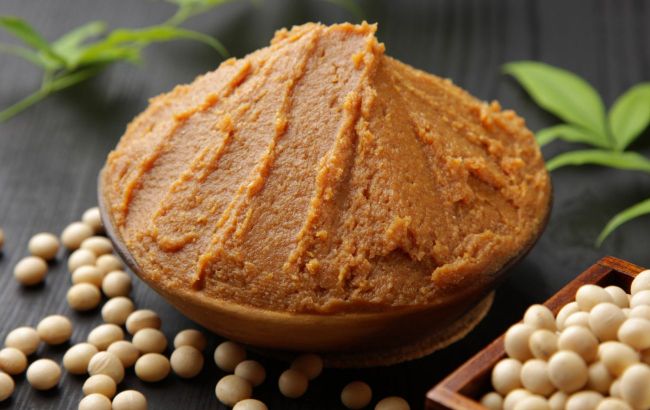Miso paste: Japanese superfood for healthy gut and more
 Photo: Why miso paste is so good for your health (freepik.com)
Photo: Why miso paste is so good for your health (freepik.com)
Miso paste is considered one of the healthiest foods in the world. Fermented miso paste rejuvenates, aids in weight loss, lowers sugar and cholesterol levels, reduces blood pressure, and decreases cancer risk. Moreover, it can be added to all dishes and eaten daily, according to Strona Zdrowia.
What is miso paste
Miso is a traditional Japanese paste made from fermented soybeans with salt. Some varieties also include rice or barley. The steamed grain is fermented using koji mold (Aspergillus oryzae), a type of fungus that has been widely used in Japanese cuisine for over 2000 years. It is also used in the production of sake and soy sauce.
Koji mold produces enzymes such as amylase and glutaminase, which during the fermentation process convert proteins and starches into peptides, sugars, and amino acids, including glutamate, which is the basis of the fifth taste, umami. Koji can also be made with the fungus Saccharomyces cerevisiae and lactic acid bacteria. Depending on the type, miso paste matures from several months to 2 years.
There are over 1,000 types of miso, but the most popular ones available in stores are:
- White miso (shiro miso) – the shortest fermentation. It is the mildest and least salty with a slightly sweet taste.
- Yellow miso (shinshu miso) – aged a bit longer. It provides a mild but more tangy flavor.
- Red miso (aka miso) – aged the longest and contains the highest percentage of soy. It has a very salty taste and is slightly bitter.
- Kome miso – made with rice and soybeans. It can be white, yellow, or red.
- Genmai miso – made with brown rice instead of white. It has a sweet, mild, earthy flavor.
- Mugi miso – made with barley and soy and is gluten-free. It provides a mild and earthy taste.
Each type varies in composition and the ratio of soy to other grains used, whereas pure miso (hatcho) is solely fermented soybean paste.

There are different types of miso paste (screenshot)
Benefits of miso paste
Miso paste is considered one of the healthiest and most nutritious foods in the world. Fermented foods have many health benefits, including antioxidant properties, supporting digestion, and the immune system.
Miso contains plant proteins (glycinin and conglycinin), carbohydrates, lipids rich in polyunsaturated fatty acids (lecithin), amino acids, isoflavones, vitamins E, K, B6, minerals such as sodium, iron, calcium, selenium, phosphorus, and lactic acid bacteria.
Scientific studies confirm that miso has extraordinary healing properties. One study conducted in Japan showed that people who consumed miso soup daily had a lower risk of developing stomach cancer and heart disease. Another suggests that consuming fermented soybean products, such as miso, may be one of the reasons for improved overall health and longevity.
Additionally, miso paste:
- Has antioxidant and rejuvenating properties.
- Supports gut health.
- Aids in weight loss.
- Has anti-cancer properties.
- Lowers blood sugar levels.
- Supports immunity.
- Fights viruses and bacteria.
- Reduces inflammation in the body.
- Supports brain function.
- Alleviates menopause symptoms.
- Regulates blood pressure.
- Maintains proper cholesterol levels.
- Supports heart and bone health.
You can use miso paste daily by adding it to many dishes, especially if you suffer from diabetes, hypertension, dementia, atherosclerosis, cancer, obesity, stomach ulcers, and other gastrointestinal diseases. Miso, due to its content of probiotic bacteria, enriches the gut flora, promoting more efficient digestion, accelerating metabolism, and aiding in weight loss.
Beneficial lactic acid bacteria also reduce the risk of infections and even affect the heart and brain functions through the gut-brain axis. The connection between the gut and brain and the proper composition of the gut bacterial flora ensure the proper functioning of the nervous system and improve well-being, reducing the risk of depression and dementia.
Miso paste also contains antioxidants that destroy free radicals. This ensures a youthful appearance, delays the aging process of the body, reduces the visibility of wrinkles, and evens out skin tone.
Miso and other soy-based products are also recommended for women experiencing menopause or having painful, irregular menstruations. Soy contains phytoestrogens that act like female sex hormones, positively affecting the functioning of the female endocrine system.
How to use miso paste?
Miso paste is most often used as a base for traditional Japanese miso soup, but you can also add it to other soups, such as tomato soup or broth. Miso paste can also be used for stews, sauces, casseroles, kebabs, salad dressings, and marinades for fish, chicken, steaks, and various meat and fried dishes. In Western cuisine, where it is most popular, it is even used as an addition to desserts and sweets.

